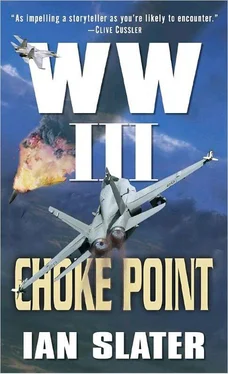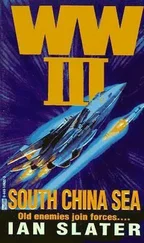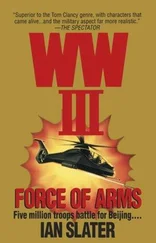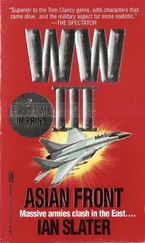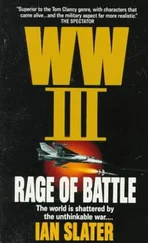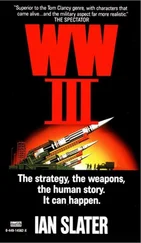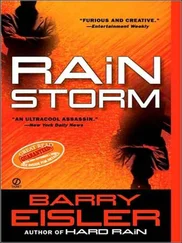In the eerie silence of the fogbound sea, the crescent bay’s shore, five minutes behind them, might have been a hundred miles away, and the sound of their paddles seemed extraordinarily loud to Freeman and Aussie. Perhaps because their sense of hearing, initially scrambled by the explosions of the torpedoes, was now straining to pick up any sound in the water about them, they both heard the faint rasping sound. It wasn’t the same noise as that of the prop, and had it not been for the small but persistent glow from the Skate ’s dying fires, Aussie wouldn’t have seen the bulbous baseball-size head of a snorkel tube rising from the sub. He stopped paddling and, not daring to whisper, tapped Freeman’s arm twice, the snorkel rising agonizingly above the sub, the enemy craft about two o’clock to the Zodiac.
Was the sub going to dive, go on batteries for a while despite the grating prop noise, far enough again to lie low and stop all engines? Given the depth reading he recalled on the Petrel , Freeman knew that it wouldn’t be too deep for a swimmer to exit through an escape air-lock hatch and replace or “putty” in a few replacement anechoic tiles.
Skate was gone, Petrel bloodied and unarmed, and, given the fog, the two hydrofoils might not get to the sub before she dived, which it looked like she’d do at any second, because there was no one on deck. Freeman was as vain a man as any other, but he’d never allowed vanity to block efficiency, and he knew that, his A-grade fitness notwithstanding, Aussie Lewis was a younger man with more strength in his arm. So he passed the two balls of LOSHOK to Aussie and quietly tipped the outboard’s prop shaft into the water, just in case.
With his mouth against Aussie’s ear, he intoned, “Tape one of ’em around the snorkel.”
They resumed paddling, Freeman estimating it would take them five to six minutes to reach the sub. The snorkel was still inching up, rasping, the sub’s skipper obviously preferring to raise it in air rather than waiting till he was submerged, where the sound would travel four times as fast to the hydrofoils.
The problem, Freeman knew, was that it would be difficult if not impossible to maintain position in the current and tape the charge to the rising pipe. The current was getting stronger. They had maybe ten minutes.
Rorke’s ability to maneuver the “Big Cigar,” as Encino called their 360-foot-long sub, had duly impressed the executive officer, especially given the level of instability in the 6881 class, caused by its sail being located farther forward than on the earlier boats of the class. Though launch site was still minutes away, the XO foresaw no problems with the launch. Encino ’s “load-out” of torpedoes and Tomahawks, following normal procedure, contained a number of variants. Of the dozen cruise missiles in the launch tubes forward of the sail, four had single thousand-pound Bullpup HE warheads, four were armed with 109D runway-cratering submunitions warheads, and the final four were capped with a doomsday “city take-out” 150-kiloton nuclear warhead.
With all presets entered into Encino ’s fire-control computer console, the attack boat rose to a point sixty feet below the surface, its speed now down from thirty knots to three. Rorke had decided to start with the four 109Ds, the navigator confirming that the intersection of the coordinates was midway down Penghu’s runway, now presumably packed with PLA fighters.
The sound of hydraulics and valves opening as the twelve forward vertical tubes were flooded in the sequence Rorke had decided upon were noises that none of the boat’s officers and men wanted to hear. They had no qualms about their part in the new post-9/11 American policy of talking softly and carrying the biggest stick you could find. But flooding, then opening, the “caps,” or lids, on each of the forward-angled twelve VLTs violated the submariner’s counsel of perfection: “Thou shalt stay silent.” The gurgling and bubbling sounds were worse than most “sound shorts,” or acoustic faults, in a boat, signaling to any hostile within hundreds or even thousands of miles away where you were. And in this case, telling them you were about to launch a weapon — whether it be an antiship harpoon, torpedo, or, as now, the Tomahawk cruise missiles.
“Up attack scope!” said Rorke.
It was unlikely there would be any ships nearby, and Encino ’s sonar hadn’t picked up anything unusual, but a visual sweep was needed just in case. Despite the awesome responsibility he had for launching such tremendous firepower, Johnny Rorke enjoyed the anticipatory moment of looking through the scope. He had not “danced” with either of the boat’s “ladies” since the Utah . He liked the physical sensation of watching the scope’s oil-sheen column rising to his command, the sensation of flipping down the scope’s arms, gripping their criss-cross nonslip handles and his eyes marrying themselves to the scope via the sensuously soft rubber cups that shut out all light in the CIC, including the luminescent green of the two target trackers’ computers and the bloodred of the weapons officer’s screen.
He moved as one with the scope, sweeping smartly through a 360-degree arc and back again, the reverse sweep to assure him he hadn’t missed anything during his clockwise rotation because of the different azimuth. All seemed clear.
“Down scope.”
With flight instructions for each missile in the computers, Rorke initiated what would be a ripple launch. The first missile fired would be one of the outermost of the six-tube configuration on the starboard side, followed immediately by the corresponding missile of the portside six.
“Commence launch,” said Rorke. This was for the crew’s benefit, as the countdown the weapons officer had already initiated was an automatic, computer-controlled function.
The crew heard the explosive charge that, along with an enormous whoosh of compressed air, ejected the cruise missile, thrusting it through the thin plastic membrane at the top of its launch tube into the sea, from sixty feet below the surface. The boat lurched slightly as the 2,650-pound Tomahawk exited the boat, seawater immediately rushing into the empty launch tube, the Tomahawk’s booster firing underwater, twenty-five feet above the sub. The missile, broaching the sea’s surface, shivered with the tremor of the booster’s fiery exhaust, the missile’s protective wing cover popping off, tailfin shrouds also discarded, four tailfins extending to steady the Tomahawk’s angle of flight.
At a thousand feet, only seconds after launch point and as another missile left Encino , the first Tomahawk’s solid-fuel booster fell away, its job done, the turbofan jet taking over, stubby wings extended. Its terrain control matching system helped to guide it, the missile flattening out at ninety feet above sea level en route to its target, virtually skimming the sea, the radar cross section no more than eleven square feet. Its approach was doubly protected by the Encino jamming the PLA radars. Traveling subsonically at plus or minus 500 mph, this small radar signature of the Tomahawk should be lost in the post-typhoon sea clutter, the missile and the eleven other Tomahawks following — a six-million-dollar “train” of explosives that Rorke’s crew, many ardent followers of the old Six Million Dollar Man , dubbed the “Six Million Dollar Slam”—scheduled to reach Penghu in approximately twenty-four minutes.
Admiral Crowley was bitterly disappointed upon hearing that Encino was given the job of “missiling” Penghu. Why hadn’t they given it to him? He’d played it smart, very smart, conducting the burial at night in blackout conditions so he’d be ready in the event any Bizarro/terrorist/kamikaze attack was launched at him in the morning when an enemy would assume the ship would slow for such a burial. Or didn’t Washington think McCain ’s battle group was up to it because of the kamikaze hit?
Читать дальше
